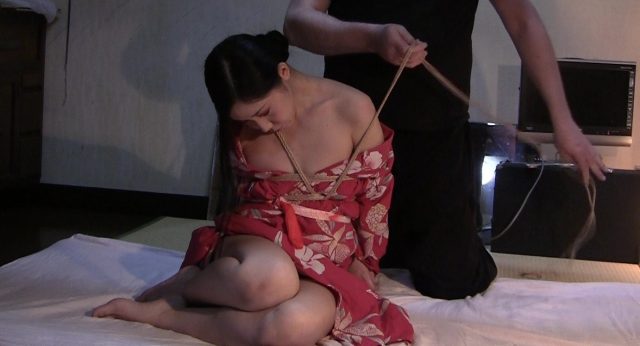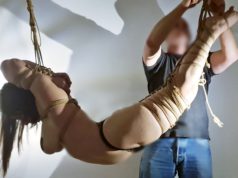When I think about tying, I think about the one rope gote. It is one of the easiest ties to do, but one of the most difficult to master.
I first learned the one rope gote from Yukimura sensei in 2011. It was unlike anything I had ever learned to tie. It had a simple but very unique construction. Tie the wrists, wrap twice around the chest, catch the ropes and create the nawajiri, the point of connection, control and communication.
Learning the technique itself takes an hour, maybe less if you are a more adept bakushi than I am.
Every time I would come back to see sensei and tie it, I would learn something new. Not new technique, but something different–a choice, a consideration, a feeling. The little things became big things. Things I had been doing without thinking became important to think about.
Over the next five years I came to realize two things. First, the point of the gote was not to make my partner feel the rope, it was to make her feel me through the rope. This is harder to do than it sounds. During my last visit, sensei would ask the model, “Could you feel him through the rope?” and he would be very stern with her and tell her “don’t lie. It is important to know the truth.” It was the most important question. Really it was the only question.
The second lesson I learned from Yukimura sensei is that the more you tie in his style, the less you know. It took me five years to understand and accept that. Every gote I tie is different and every time I share myself through my rope, I am different. Technique can get in the way of that realization. It can block you from sharing what is in your heart. The risk is that you become the pattern, the design, the tie itself, rather than the tie being an expression of you. If your rope doesn’t start with heart, with feeling, it will never be anything more than just technique.
Mastering the gote, even a simple one rope gote, is partly mastering yourself and learning to make the rope an extension of yourself. It is your tool for communication. It is your means of expression. Like words it is multifarious, layered, complicated, filled with nuance and meaning. Technique is merely grammar and vocabulary. You need it to communicate, but alone it isn’t going to allow you to say very much.
It is the difference between reciting someone else’s poem and writing your own.
I like to think of my rope as a conversation where rope, reactions, and intentions take the place of words. It is something I do with my partner, not to them.
So how do I get my partner to feel me through my rope? That is a much harder question to answer. I can teach you the technique in an hour. I am not sure the rest can be taught. But it can be learned. That learning is a process which requires mindfulness, reflection, attention, and presence.
Over the years there are many things Yukimura sensei has said to me that made a deep impression. Almost all of them were things I thought I understood at the time. Almost all of them have produced moments of clarity or revelation at a later time. Those are the “Ah ha!” moments where I finally got what it was that he meant, sometimes months or even years later. They are deceptively simple ideas that become complicated and nuanced with experience.
Sometimes Yukimura would say things like “the first attack of the gote is the essence of Yukimura Ryuu.” In one sense that tells you everything, but in practical terms it tells you nothing. What it told me was to pay attention to that moment and see what I could learn about how I communicate with my partner and how she communicates back to me.
After 100 gotes, I knew more. After 1000, even more. Finally, there is no technique and no knowing, there is only feeling and if your mind is mired in technique you will miss the moment altogether.
I know the next gote will be different, the feeling will be different, the moment will be different, the reaction will be different. In that moment, I have to realize I know nothing and trust that feeling is everything.
It all happens in the blink of an eye, the moment where rope touches skin, where the first pressure is applied, where your touch transmits your intention, your emotion, your mental state.
To make matters worse, almost all of the magic is invisible. When we starting thinking past technique, we integrate our feeling and emotion into our actions. They disappear into the rope. There are no wild gestures, flinging of rope, or dramatic moments.
There are dozens of things that sensei shared, some of which I understand and some of which I hope will become more clear with time. Technique is static, it changes very little over time. At its best, it gets distilled to its essence, it becomes safer or more effective. Heart is the opposite–ever evolving, ever changing, it is the dynamic essence of how I see rope and how I want to tie.
What Yukimura sensei left behind was not technique, but a philosophy. It is a way of thinking about rope that opens a door to a lifetime of learning and growth. I do not think I will ever exhaust the resources he gave me.
The technique takes an hour to learn. The rest requires a lifetime.







